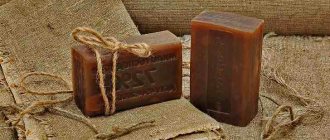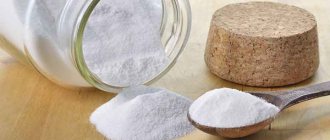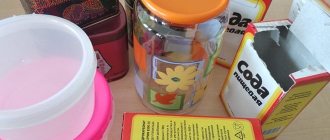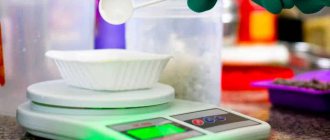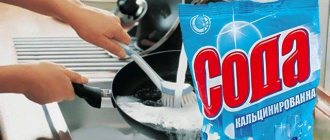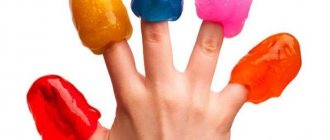Chemical composition
The difference in the properties of soda is due to the difference in chemical composition.
Sodium bicarbonate, also called baking soda, tea or drinking soda, sounds like NaHCO3 in the language of chemists. The acidity level of this compound is almost neutral, Ph is 8. Externally it is a fine white powder. This type of connection is absolutely safe for humans and working with it does not require the use of protective equipment.
Sodium carbonate, or soda ash, has the formula Na2CO3. The substance is highly alkaline, Ph is 11. There are two brands of this sodium salt of carbon dioxide. Brand A is in the form of granules, brand B is available in powder form. Both types of sodium carbonate have a strong irritant effect on the skin and mucous membranes. Interaction with them is possible only in personal protective equipment and rubber gloves.
Storing soda ash
Sodium carbonate is a friable powder without lumps. In special packaging it can be stored for up to 5 years. Once the container is opened, baking soda can be stored for up to 25 days.
Sodium carbonate actively absorbs moisture from the air. If the package in which it is contained is open, the compound loses its properties and gradually cakes.
After opening the package, it is better to store the soda in a glass container, tightly closing it with a plastic lid. The bank must definitely sign it.
Extraction methods
The main sources of sodium carbon dioxide salts are considered to be throne and nakholite. Deposits of these minerals are located throughout the world in more than sufficient quantities. One of the largest deposits of trona is located in the United States, and its reserves alone will last for two millennia. Soda ash extracted from the throne and nakholite is converted into food grade by calcination.
A chemical method for producing soda is also used. Sodium chloride is exposed to ammonia and carbon dioxide. As a result, sodium carbonate is formed. After calcination, bicarbonate or baking soda is obtained. This method was invented by the Belgian chemist Solvay, and it is named after him.
Both extraction options involve the production of sodium carbonate. And baking soda is produced from soda ash.
Recommended for you:
How to make soda ash from baking soda at home
Sodium carbonate for garden care
Soda solutions help defeat diseases of cultivated plants caused by high humidity. Experienced gardeners recommend using sodium carbonate in the fight against powdery mildew, viburnum leaf beetle and other common scourges.
Plant treatment
- Powdery mildew
- Dissolve two tablespoons of baking soda in a bucket of water.
- Add 40 grams of crushed laundry soap, stir until completely dissolved.
- On a windless day without heat or rain, spray the garden. Treatment can be carried out once a week. For prevention, it is useful to spray the solution once or twice in the spring during flowering.
- Perennial flowers
- Dissolve four tablespoons in a bucket of water.
- Spray the plants periodically during the flowering period.
To eliminate gray rot, water the flowers once every two weeks with a solution of a tablespoon of soda per 10 liters of water.
- Viburnum leaf beetle
- Grind a bar of green potassium soap.
- Dissolve soap shavings in a bucket of water.
- Add a tablespoon of sodium carbonate.
- Treat the back of the leaves once a week until the disease goes away.
- Rose bushes
You can rejuvenate roses with the following composition:
- Water - 5 liters.
- Soda ash - a teaspoon.
- Ammonia - half a teaspoon.
- Epsom salt - teaspoon.
Every 10 days, water or spray the roses with this solution. If the plant is young, exclude ammonia from the recipe.
If you are an avid summer resident, you probably know about the use of soda ash in the garden.
Getting rid of aphids
Gardeners have known for a long time that aphids can be killed with soda quickly and effectively. The method, with proven effectiveness, is also popular because it simultaneously increases productivity and protects plants from mold and many diseases. Soda solution can be used to treat flowers, fruit trees, berry bushes, garden and indoor plants.
Alkali in combination with soap creates unbearable conditions for pests, but they cannot escape - the viscous soap layer gets in the way.
- Rub laundry (300 g) or tar (100 g) soap.
- Dissolve the soap in warm water.
- Add a tablespoon of sodium carbonate for every two liters of water.
You can add a teaspoon of iodine to this composition to speed up the recovery of damaged plants. Chopped garlic in a soda solution will repel aphids from your area for a long time.
Do not overuse the soda-soap treatment, otherwise the leaves in your garden will turn yellow and fall off prematurely. The interval between treatments is at least a week. The last spraying is three weeks before harvest.
You might be interested in: Baking soda for the garden or vegetable garden - an indispensable lifesaver for a summer resident
Technical soda for weeds
Dealing with weeds in the garden can be easier than destroying unwanted vegetation that stubbornly makes its way between paving slabs, near the walls of the house and under the fence. In this case, you do not need to worry about the health of the plants - water the problem areas with soda ash concentrate. The effect will increase if you choose a hot and dry day for the fight.
You may be interested in: Treatment of vineyards with baking soda against diseases during ripening
Use in the food industry
It is difficult to imagine the modern food preparation industry without baking soda. Sodium bicarbonate is widely used as a leavening agent. This makes it indispensable in bakeries and confectionery shops. Any housewife knows how to use a pinch of soda to make a cake fluffy and filled with air bubbles.
Besides baking, bicarbonate is used in the following recipes:
- in marinade for meat and poultry;
- as part of omelettes;
- in vegetable salads and stews;
- in coffee and tea drinks;
- when making homemade cheese;
- in milk porridges.
The taste of the most famous childhood dishes is strongly associated with sodium bicarbonate.
Sodium carbonate, on the contrary, is used quite rarely in the food industry. Mainly in the form of preservative E500.
Where does scale come from?
The cause of scale is calcium and magnesium salts. When water boils, salts precipitate and form hard growths on the inner surface of dishes, boilers, and washing machines. You have probably heard that water can be “hard” and “soft”. This depends on the amount of salts dissolved in it; the more, the “harder”. When the inside of the kettle is “overgrown” with scale, the taste of the drinks noticeably deteriorates, white flakes appear in the cups, and the water has a specific smell. This suggests that it is high time for you to clean the kettle.
Cleaning properties
Using baking soda as a cleaning agent is a life hack that almost everyone knows. The substance gained such popularity due to the combination of high efficiency and gentle treatment of surfaces. Among the many options for using bicarbonate at home, there are several of the most popular.
- In combination with laundry soap, bicarbonate perfectly removes traces of soot and grease. When mixed with a small amount of water, a thick mass is obtained. It can easily wash the stove or dishes without causing damage to the surface.
- Dry powder is used as an absorbent substance when cleaning fur products. Light fur requires extremely delicate cleaning and does not tolerate excess water. Baking soda is sprinkled on the surface of the fur and after a short period of time it is shaken out or combed out. Dust and dirt are removed along with the powder.
- The disinfectant properties of bicarbonate are useful when cleaning the inner surface of leather shoes. In addition to cleanliness and freshness, this method will prevent the appearance of fungal diseases and unpleasant odors.
- A mixture of liquid laundry soap and bicarbonate will completely replace washing powder, including automatic washing powder. The resulting gel is highly soluble in water, is completely washed off and is an environmentally friendly product. It is considered hypoallergenic and suitable for washing children's clothes.
Expert opinion
Did you know that...
Soda ash is also often used as a cleaning agent. It copes with the most difficult dirt and stains. The substance should not be used on delicate fabrics and surfaces. There are many examples of purification using carbonate.
- Sodium carbonate quickly and thoroughly removes mineral deposits. This makes it an effective cleaner for plumbing fixtures and ceramic tiles. A mixture of powder and water in one to one proportions is applied to the surface using a sponge. After a few minutes, the remaining rust and limescale are washed off with water.
- The beneficial properties of the substance include reducing water hardness. Therefore, the product can replace expensive products for washing machines and dishwashers. Adding a small amount of powder at each cycle will remove existing deposits on the heating elements and prevent them from reappearing.
- Sodium carbonate can be used as a bleach on thick fabrics such as linen or cotton. Additionally, the substance removes various types of stains, including greasy ones. Soaking kitchen towels in a weak solution will leave them feeling fresh and clean.
- Sodium carbonate is used as a clog clearer. The product is highly alkaline and therefore effectively dissolves congealed grease in sewer pipes.
- This type of carbon dioxide salt is included in many paints. It can also remove paint stains from clothes and various surfaces. When combined with slaked lime, it is able to completely dissolve the old layer of pigment.
Expert opinion
We recommend!
Sodium carbonate is more caustic than bicarbonate. Both carbon dioxide salts have proven themselves well as cleaning agents. Food-grade works well with moderately complex stains and is suitable for any surface; calcined removes even stubborn stains, but is not used on materials that are not resistant to alkalis.
How to prepare the solution
Soda ash can be used to wash dishes, clean pipes, and get rid of faded stains on clothes. This universal product relieves the housewife of the need to keep a whole arsenal of household chemicals at home for various needs.
Before use, it is necessary to make a solution of soda ash of the required concentration. Additional components are often added to it - soap, washing powder, ammonia. It is important to remember that too much product can cause damage to things and surfaces. The ratio of water and powder, depending on different purposes and household needs, is presented in the table.
Table - Amount of soda ash for domestic purposes
| Target | Proportions (soda - water) |
| Handwash | – 3 tablespoons per 10-12 l |
| Automatic wash | – 3-5 tablespoons (depending on water hardness); – 200 g per 5 kg of white laundry |
| Water softening (for example, for pouring into an iron) | – 2-3 tablespoons per 10 l |
| Cleaning the drum and cuff of the washing machine from dirt and mold | – 6 tablespoons per 200 ml |
| Mopping floors | – 3 tablespoons per 5 l |
| Washing dishes | – 3 tablespoons per liter |
| Toilet disinfection | – 2-3 tablespoons of soda and soap shavings per 200 ml (makes a paste) |
| Cleaning tiles | – 2-3 tablespoons per liter |
The same dose of powder can act differently depending on the temperature. The hotter the water, the more active the substance. The powder dissolves poorly in cold water, forming flakes. Therefore, it is optimal to use warm or cool water at room temperature for mixing.
Use in various industries
Sodium carbonate is used in many enterprises and industries. It is most often found in the following areas:
- soap making;
- glass production;
- production of pulp, cardboard and paper;
- leather dressing;
- in the chemical industry.
Recommended for you:
Natural bob's red mill soda: differences from regular soda, application
Sodium bicarbonate plays an important role in the food industry. In addition to it, the substance is applicable in several directions:
- production of medicines;
- production of artificial leather;
- rubber production;
- in the chemical industry and metallurgy.
Both versions of sodium carbon dioxide salts are used in the manufacture of a wide variety of things and are included in many products.
A little chemistry
The substance molecule consists of a trivalent oxygen compound with two sodium atoms and one carbon atom. When interacting with water, it forms an alkaline solution with pH=11.
Salt is active in interaction with chemicals, which has led to its widespread use, both in industry and in everyday life. This is one of the available analogues of advertised household chemicals. On store shelves you can find both crystalline powder and granules.
Be sure to read the instructions before use.
Safety
Considering the high Ph of sodium carbonate, its use in everyday life should be carried out using safety precautions. The skin of your hands must be protected with rubber gloves. When the substance gets on the mucous membrane or open area of the skin, it causes severe burning, redness and itching.
When heated, the substance easily evaporates; you can avoid burns to the respiratory tract by wearing a respirator. It cannot be consumed as food; soda is technical.
Recommended for you:
How to apply and use soda ash at home
Bicarbonate has an almost neutral acidity level. This makes it safe for humans, including direct contact with skin. This product cleans so gently that it can be used as a whitening toothpaste.
Where not to use
There are materials for which contact with soda ash is strictly contraindicated. For example, paint may come off after such treatment. Also, do not wash suspended ceilings with alkali. Four more surfaces that don’t “like” laundry soda.
- Delicate materials. Sodium carbonate is harmful to silk, wool, leather, impregnated fabrics, membrane surfaces, leatherette and suede.
- Aluminum, cast iron and plastic. Aluminum and cast iron have already been discussed above. Also, do not use the product for general cleaning of the refrigerator. When exposed to strong alkali, plastic can deteriorate.
- Wood, varnish. Sodium carbonate is harmful to the surfaces of wooden and lacquered furniture: the polish may be damaged.
- Fiberglass. Bricks and tiles made from fiberglass also do not like soda ash.
It is difficult to guess how recently invented modern materials may behave after contact with alkali. For example, linoleum can be processed, but laminate is deformed. It is better not to experiment and avoid contact with plastic and rubber products, PVC windows, bathtubs with acrylic coating, shower doors made of triplex, and leatherette upholstery.
Possible harm
Baking soda should be consumed internally in limited quantities and according to strict indications. Bicarbonate crystals in large quantities are toxic to the mucous membrane of the digestive system and can cause severe irritation and allergic reactions.
It is not recommended to use solutions based on sodium bicarbonate for people suffering from erosive and ulcerative processes of the stomach and intestines, low stomach acidity and anacid gastritis.
If you regularly inhale carbon dioxide vapor or bicarbonate crystals, for example, in the production of soda, irritation of the respiratory mucosa may occur.
Frequent use of soda solution threatens persistent organic disorders of the digestive system. Alkalinization of gastric juice occurs, as well as a shift to the highly alkaline side of the intestinal contents.
